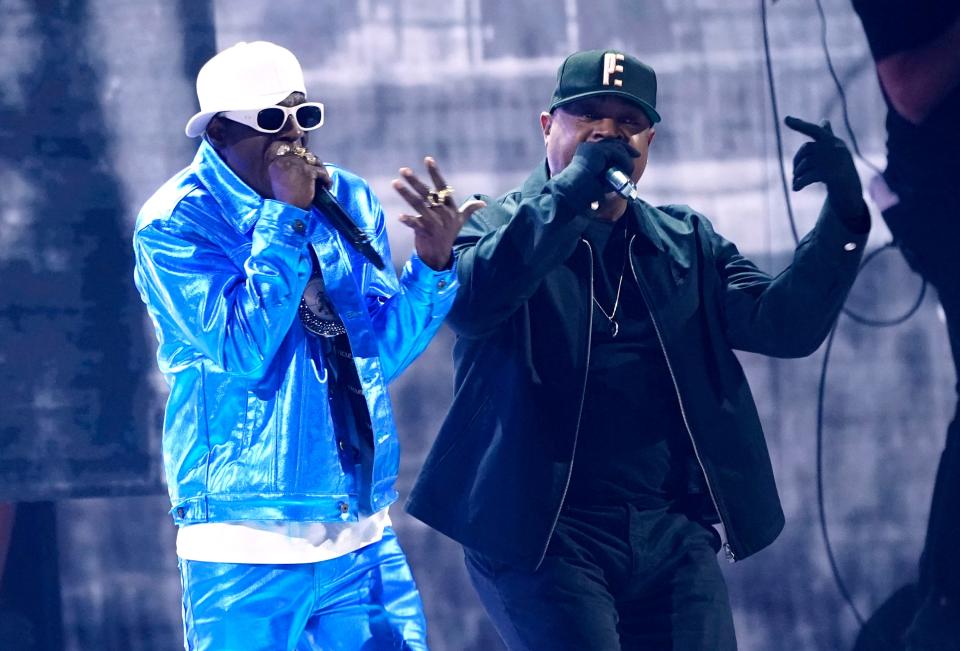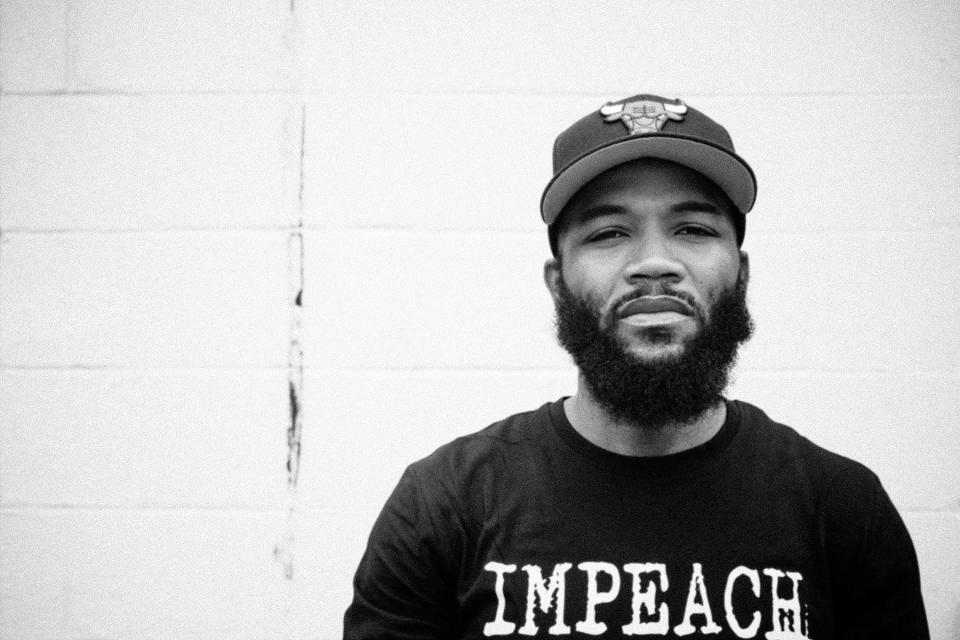The news at 9, with a beat and a rhyme: Rappers as citizen reporters | Matters of Fact
- Oops!Something went wrong.Please try again later.
- Oops!Something went wrong.Please try again later.
- Oops!Something went wrong.Please try again later.
Correspondents. That's what journalists were called, back in the day.
It was a day when travel was harder, places were less accessible, and newspapers relied on actual correspondence — letters, written by colleagues on the ground, from Paris, Istanbul, China, and any other remote locale that was considered a hot spot.
In 1982, a new kind of correspondent appeared, reporting from a new war zone.
The byline was Melle Mel — aka Melvin Glover. The name on the masthead was Grandmaster Flash and the Furious Five. The news outlet was Sugar Hill Records — the pioneering hip-hop label based in Englewood.

The dateline was the South Bronx.
"Broken glass everywhere, People pissing on the stairs, you know they just don't care."
That, in newspaper-speak, is what is known as a "scene-setter."
"You could smell the 'hood in the song," Glover said, speaking to The Record last year on the occasion of "The Message's" 40th anniversary.
"The Message," released on the Sugar Hill label on July 1, 1982, was a new wrinkle in a music genre that was itself still new to most people.
Beckerman: Fran Lebowitz always speaks her mind as a quintessential New Yorker, by way of Morristown
"The Message" was funky. It was danceable. But it also contained something that few Billboard charting hits (No. 4 on Billboard Hot Soul Singles) had ever attempted. Reporting. Editorializing, even. Not for nothing was it called "The Message."
"A child is born with no state of mind, Blind to the ways of mankind."
"The Message" was a watershed in the history of hip-hop. It was the first big hit of so-called "conscious" rap or "knowledge" rap. It would not be the last.
"Rap music is the invisible TV station that Black America never had," Chuck D of Public Enemy said in 1989. "We're almost like headline news ... Public Enemy and rap music are dispatchers of information."
A new kind of reportage

Newspapers, we now know, can take many forms: tablets, smartphones, social media platforms. With "The Message," the news was dispatched as beats and rhymes — but no less the news for that.
"I think Chuck D was saying there is a potential for a kind of reportage that exists in rap, that can go into spaces that CNN won't go," said A.D. Carson, assistant professor of hip-hop and the Global South at the University of Virginia.
"The things that are going on in the neighborhood are being reported by the songs," Carson said. "They're not being invented by the songs."

"Citizen reporters" is a concept we're all familiar with now, in an age of iPhones and social media.
But it wasn't so much a thing in the early '80s, when Melle Mel, Scorpio (aka Eddie Morris) and other members of the Furious Five took it on themselves to record what life was like, for them, in the South Bronx. They knew their beat. Melle Mel lived on 165th Street. Scorpio lived on 166th.
"It was like we were living in Beirut," Scorpio told The Record. "For us, it was normal. That was our playground. We used to go into dirty buildings — everywhere we walked we were stepping over dope needles. That's all we had."

Matters of Fact | A column about our lives in the age of media
This period, the late '70s and early '80s, was rock bottom for the South Bronx, an area that was as culturally and musically diverse — hence the flowering of hip-hop in the '70s — as it was economically desperate. Redlining and racism had killed local investment. Crime and drug use were out of control.
The housing stock was old, and it had a habit of suspiciously bursting into flame — "Ladies and gentlemen, the Bronx is burning," said an incredulous Howard Cosell, broadcasting from Yankee Stadium in 1977. It was something that outsiders blamed on residents, and residents blamed on landlords. But few outsiders ever set foot there. Certainly, few reporters from mainstream papers. The South Bronx was not their coverage area. There was a "total news blackout," as they say in the business.
Into the breach stepped a new kind of on-the-spot reporter, mic in hand.
"Rats in the front room, roaches in the back, Junkies in the alley with a baseball bat."
"These were things you could relate to," said Leland Robinson, son of the late Sylvia Robinson, creator of the Sugar Hill label. "They were about life, what the average person went through, so basically if you were were going through a struggle, you were able to relate."
After "The Message," there was more coverage. And then more.
Telling the stories through song
The drug epidemic was dealt with in "White Lines (Don't Do It)," another Melle Mel editorial. "Twice as sweet as sugar, twice as bitter as salt, And if you get hooked, baby, It's nobody else's fault — so don't do it." And no reporter was as eloquent on the city's wealth disparity as Mel's "New York, New York": "A castle in the sky one mile high, Built to shelter the rich and greedy, Rows of eyes disguised as windows, Looking down on the poor and needy."
At a time when few news outlets thought such neighborhoods worth covering, and few had any appreciable nonwhite presence in their newsrooms — many still don't — this was filling a need.
For residents, it was an affirmation: Others are going through what I'm going through. For outsiders, those in the suburbs and rural America, those not of color, it was a window into a world they knew nothing about.
"I think it will be as valuable a document as any other kind of media we have, including the news," Carson said. "People will look back on it, the same way they might look at the archives of a particular media network."
And if news from the South Bronx could be "reported out," as journalists say, so could news from South Central L.A., Detroit, and lots of other places mainstream media wouldn't venture. Dateline: "Straight Outta Compton."
"Just like burglary, the definition is 'jackin' " N.W.A.'s Ice Cube informed his listeners. "And when illegally armed it's called 'packin.' "
That, in journalism, is called an "explainer."
Still keeping rap real?
And just like that, news had a new platform. N.W.A., Public Enemy, Lauryn Hill, Kendrick Lamar, Common, Mos Def, Jay-Z: These are just some of the artists, through the years, who have taken on the mantle of reporters and commentators.
Not that all rapping is so public-spirited. Hip-hop, these days, is a $2.7 billion industry with a worldwide audience, as full of nooks and crannies as an English muffin. There's Trap, Crunk, Drill, Bounce, Gangsta, G-Funk — dozens of flavors. But one thing that has always been central to the hip-hop experience is a word that is common to both rap and reporting: "Credibility." As in "street cred."
"Its about how real they are, or how real they seem," Carson said. "Certainly there are expectations. The engagement of the audience is rooted in what is perceived as authenticity."
That quest helped give rise to some of the more problematic aspects of hip-hop. The violence, the feuds — those were credentials, considered necessary to a reliable witness of the urban scene. People expect their war correspondents to report from the trenches.
"When a rapper gets shot, rappers get more media coverage," Carson said.
Ironically, rap these days is subject to the same market forces as the news business, he said. As both become more global, both become less "real" — less rooted in a specific place and experience.
"The businesses are run in very similar ways," said Carson, who has studied the intersections between business, politics and Black culture in several media, including a Ph.D. dissertation in the form of a rap album.
Community newspapers and TV stations get absorbed into big conglomerates — and in so doing, they lose their sense of local identity. Similarly hip-hop, once identified with particular neighborhoods like the South Bronx, becomes something amorphous, placeless, streaming from The Cloud. Who knows where the artists come from? Who knows what, if anything, is real about their rhymes?
In each case, the emphasis is less on credibility, more on entertainment, Carson said.
"The trajectory is interesting to think about," he said. "Local news, versus a media conglomerate that is canning news and giving it to you locally. Rap is place- and space-based. How does that change, when we have places and spaces we don't physically need to be in? It's no longer Compton or Chicago or Brooklyn, it's Soundcloud or Bandcamp or Apple Music."
In short — and this goes for some of what passes for news as well as a lot of rap — it doesn't have to be the truth. It just has to be, to use Stephen Colbert's word, "truthy." And that's worrying.
"We're in an ecosystem where it doesn't have to be real," Carson said. "It just has to feel real."
This article originally appeared on NorthJersey.com: Hip-hop turns 50: Rappers as journalists and storytellers

